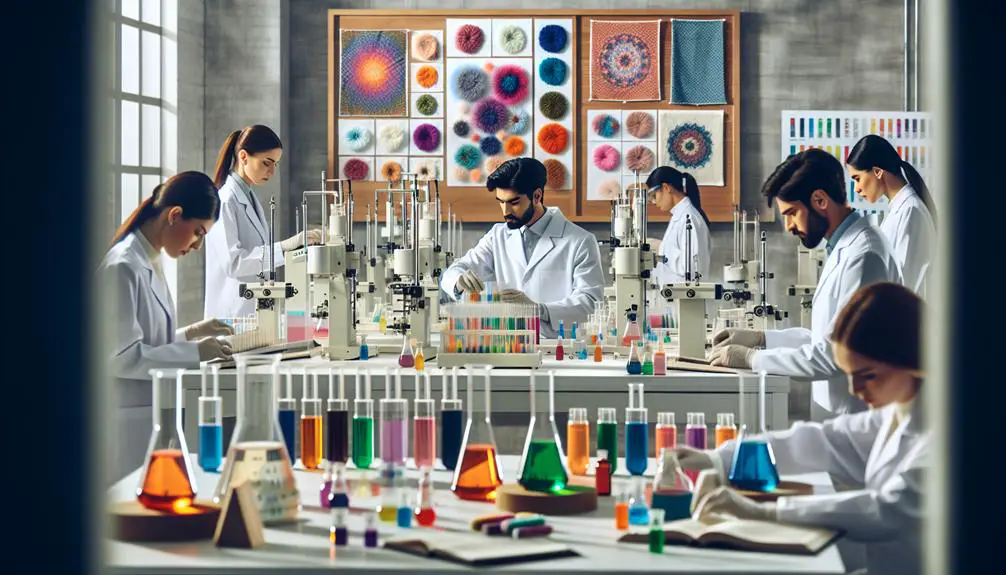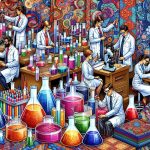Did you know that the global textile chemicals market is projected to reach nearly $30 billion by 2025? You might not realize it, but chemistry is everywhere in textile production, from creating synthetic fibers to treating natural ones. It's not just about making fabrics look good; it's about ensuring they are functional and sustainable too. For instance, advancements in dye chemistry are now focusing on reducing environmental impact. So, how exactly do these chemical processes work, and what innovations are shaping the future of textiles? Let's explore the intricate world where chemistry meets fabric.
Table of Contents
Key Takeaways
- Chemistry enables synthetic fiber creation by combining chemicals and understanding polymerization reactions.
- Chemical treatments enhance natural fibers' durability, softness, and dye affinity.
- Dye chemistry relies on pH balance and covalent bonding for effective color absorption.
- Chemical coatings and treatments improve fabric durability, appearance, stain resistance, and functionality.
- Sustainable chemistry practices in textile production reduce environmental impact and promote eco-friendliness.
Synthetic Fiber Creation
In synthetic fiber creation, you combine various chemicals to produce materials like nylon and polyester. Mastering this process involves understanding polymerization reactions, where monomers link to form polymers. You'll start with monomers like adipic acid and hexamethylenediamine for nylon or ethylene glycol and terephthalic acid for polyester. These monomers undergo polymerization reactions, creating long, repeating molecular chains essential for strong fiber properties.
Once you've obtained your polymer, it's spun into fibers through techniques like melt spinning or solution spinning. In melt spinning, you heat the polymer until it melts, then extrude it through a spinneret to form fibers. Solution spinning dissolves the polymer in a solvent before extrusion. Each method impacts fiber properties such as tensile strength, elasticity, and moisture absorption.
You'll also need to adjust the polymer's molecular structure to achieve desired characteristics. For example, you can increase chain length or add specific side groups. By mastering these modifications, you can produce fibers customized for different applications—from durable outdoor gear to soft, breathable fabrics.
Understanding and controlling the chemistry behind these materials guarantees you create high-performance synthetic fibers ready for any textile challenge.
Natural Fiber Treatment
Treating natural fibers involves processes that enhance their durability, softness, and dye affinity. You'll find that chemistry plays a vital role in achieving these goals while maintaining fiber sustainability.
Start with scouring, which removes natural oils and impurities from fibers like cotton and wool. This step is essential for eco-friendly processing as it prepares the fibers for subsequent treatments without harsh chemicals.
Next, consider bleaching, which whitens the fibers and improves their ability to absorb dyes. Opt for oxygen-based bleaches over chlorine-based ones; they're less harmful to the environment.
Enzymatic treatments can further enhance softness and durability. Enzymes like cellulase break down rough surface fibers, resulting in a smoother, more pleasant texture.
Mercerization, another important step, involves treating cotton with sodium hydroxide. This process increases the fiber's luster, strength, and dye receptivity. While it may seem less eco-friendly, modern methods recycle chemicals, aligning with sustainable practices.
Lastly, explore eco-friendly finishing agents that add functionalities like wrinkle resistance and water repellency without compromising fiber sustainability. These agents should be biodegradable and free from harmful substances, ensuring that your natural fiber treatments are both effective and environmentally responsible.
Dye Chemistry
Understanding dye chemistry is important for achieving vivid, long-lasting colors in textile production. It's not just about selecting a dye; you need to comprehend how pH balance affects color absorption.
Different fibers react uniquely to dyes, and controlling the pH can improve these reactions. For example, cotton fibers absorb reactive dyes best in an alkaline environment, while protein fibers like wool require acidic conditions for the best color uptake.
You'll also need to take into account the chemical reactions involved. When dye molecules bind to fiber molecules, they often form covalent bonds, which are more resistant to washing and fading. This bonding process varies with different dyes and fibers, so knowing your materials inside out is important.
For instance, direct dyes bind easily with cellulose fibers, while acid dyes work well with protein fibers due to their specific chemical structures.
Fiber reactivity plays a notable role in how well a dye adheres and how the color appears. Some fibers have more reactive sites, allowing for better dye penetration and therefore more vivid colors.
Fabric Finishing
When you explore fabric finishing, you'll see how chemical treatments can greatly enhance fabric durability.
These treatments include processes that make fabrics water-resistant, wrinkle-free, and more.
Chemical Treatments Used
In fabric finishing, chemical treatments enhance the durability, appearance, and functionality of textiles. When you're aiming for textile preservation, maintaining the pH balance is essential. Alkaline or acidic environments can degrade fabric fibers over time, so treatments that stabilize the pH make a significant difference. This careful management of pH guarantees that your fabrics resist wear and tear, extending their lifespan.
One key aspect you can't overlook is color fastness. Chemical treatments are necessary for locking in dyes, making sure that your textiles don't bleed or fade after multiple washes. This not only keeps the fabric looking vibrant but also contributes to fabric strength. Stronger, color-fast textiles are less likely to suffer from common issues like pilling or tearing.
You'll also find that chemical treatments can impart additional desirable properties to your textiles. For instance, wrinkle resistance and stain repellency are often achieved through the application of specialized finishing agents. These treatments allow your fabrics to maintain a polished appearance with minimal maintenance.
Enhancing Fabric Durability
Chemical treatments not only enhance fabric appearance but also play an important role in boosting its durability. When you apply these treatments, you're essentially strengthening the fabric's power and resilience. Through chemical bonding, fibers become more resistant to wear and tear, ensuring that the material can withstand the rigors of daily use.
Let's talk specifics. Treatments like resin finishing and cross-linking agents increase fabric strength by forming strong chemical bonds between fibers. This process not only makes the fabric more durable but also greatly improves its resistance to abrasion and stress. You'll find that fabrics treated in this way maintain their integrity far longer than untreated ones.
Another vital aspect of enhancing fabric durability is moisture management. Chemical finishes can be applied to fabrics to repel water and resist stains, thereby reducing the likelihood of damage from spills or environmental factors. These treatments also help fabrics retain their shape and elasticity, further contributing to their resilience.
Chemical Coatings
Many textiles get their durability and functionality from specialized chemical coatings that enhance their performance. You can find waterproof textiles that owe their resilience and water-repellent properties to these coatings. By applying a thin layer of specific chemicals, manufacturers can greatly enhance a fabric's durability, making it ideal for outdoor gear and activewear.
However, the quest for sustainability is driving the industry toward chemical-free alternatives. These sustainable practices aim to reduce environmental impact while maintaining or even enhancing the fabric's performance. Innovations include using natural waxes or bio-based polymers as substitutes for synthetic chemicals.
To give you a quick comparison:
| Feature | Traditional Chemical Coatings | Chemical-Free Alternatives |
|---|---|---|
| Durability Enhancement | High | Moderate to High |
| Waterproof Textiles | Yes | Yes, with natural treatments |
| Environmental Impact | High | Low |
| Cost | Variable | Often higher initially |
| Sustainability | Low | High |
As you can see, both approaches have their pros and cons. Mastering the application of chemical coatings or their eco-friendly alternatives can make a substantial difference in the textile's performance and environmental footprint. Choose wisely based on your specific needs and sustainability goals.
Stain Resistance
While chemical coatings improve durability and waterproofing, they also play a significant role in making textiles stain-resistant. You can appreciate how these innovations provide an extra layer of fabric protection.
Chemical solutions engineered for stain prevention make sure that spills and dirt don't penetrate the fibers, making it easier to maintain the pristine condition of your garments.
Here's how stain-resistant treatments benefit you:
- Simplified Cleaning: Stains lift off with minimal effort, saving you valuable time and energy.
- Extended Lifespan: Textiles last longer as they're safeguarded from permanent stains and wear.
- Enhanced Appearance: Fabrics maintain their original look, preserving their aesthetic appeal.
By incorporating these advanced chemical solutions, textile innovation has reached new heights. Modern stain-resistant fabrics utilize a range of technologies, from fluorochemicals to nanoparticle coatings, to create an effective barrier against contaminants.
This proactive approach to stain prevention not only enhances everyday usability but also aligns with your desire for high-performance, low-maintenance textiles.
Understanding the chemistry behind these protective measures empowers you to make informed choices, guaranteeing your fabrics meet the highest standards of quality and functionality. Embrace these advancements to elevate your textile experience.
Flame Retardants
Flame retardants greatly enhance the safety of textiles by reducing their flammability. When you incorporate these chemicals into fabrics, they effectively slow down the ignition process, giving you valuable extra time in case of a fire. Understanding flame retardants' effectiveness is essential.
You need to know that not all flame retardants work the same way; they vary based on the type of fabric and intended use. For instance, some are designed to form a protective barrier, while others work by releasing flame-inhibiting gases.
Meeting regulatory standards is another vital aspect. Different countries have specific guidelines that textiles must meet to be considered flame-resistant. You should familiarize yourself with these standards to guarantee compliance.
For example, the United States has stringent regulations like the California Technical Bulletin 117 (TB117), which outlines the requirements for flame resistance in upholstered furniture. Adhering to these guidelines not only ensures safety but also boosts consumer confidence in your products.
Antimicrobial Treatments
When exploring antimicrobial treatments, you'll find various agents like silver nanoparticles and quaternary ammonium compounds. Each type has its own unique properties and effectiveness.
Understanding the different application methods will help you choose the best approach for your textile needs.
Types of Antimicrobial Agents
In textile production, antimicrobial agents like silver nanoparticles, triclosan, and quaternary ammonium compounds are important for preventing microbial growth and guaranteeing fabric longevity. These agents play a vital role in medical textiles, where hygiene and textile preservation are essential. By integrating antimicrobial treatments, you can extend the life of fabrics and reduce the frequency of replacements, promoting textile sustainability.
To give you a better grasp, here's a closer look at these agents:
- Silver Nanoparticles: Known for their broad-spectrum antimicrobial properties, silver nanoparticles are effective against bacteria, fungi, and viruses. They're widely used in medical textiles and high-performance fabrics.
- Triclosan: This organic compound disrupts bacteria's cell walls, making it a popular choice for everyday textiles like socks and sportswear. Triclosan guarantees that your fabrics remain odor-free and hygienic.
- Quaternary Ammonium Compounds: Commonly used in textile engineering, these compounds are effective against a wide range of microorganisms. They offer long-lasting protection and are often applied to hospital linens and uniforms.
Understanding these agents helps you make informed decisions in textile production, enhancing both durability and hygiene, essential for medical environments and everyday use.
Application Methods Explained
Now that you grasp the types of antimicrobial agents, let's explore how these treatments are applied to textiles.
One common method is pad-dry-cure, where the fabric is soaked in an antimicrobial solution, then dried and cured to achieve chemical bonding. This bonding guarantees the agents are firmly attached to the fibers, preserving the textile properties you desire.
Another technique is exhaustion, which involves immersing the fabric in a solution until the antimicrobial agents are fully absorbed. This method benefits from uniform distribution, enhancing both color fastness and overall performance.
You can also use surface coating, where antimicrobial agents form a protective layer on the textile surface. This approach is often used for textiles that require specific touch and feel.
When choosing an application method, always consider the end-use of the textile. Durability testing is essential to ensure the antimicrobial treatment withstands repeated washing and wear. You don't want the treatment to compromise the fabric's texture or elasticity.
Achieving a balance between effective microbial resistance and maintaining intrinsic textile properties is key. With precise application and thorough testing, you'll secure your textiles remain both durable and protective.
Environmental Impact
Textile production contributes extensively to environmental degradation through the release of harmful chemicals and excessive water usage. You're likely aware that this industry is one of the biggest polluters globally. However, understanding the full extent of its environmental impact is essential for implementing effective waste management and sustainability practices.
To mitigate these effects, you should consider:
- Adopting eco-friendly alternatives: Opt for natural dyes and biodegradable materials to notably reduce the sector's carbon footprint.
- Implementing rigorous waste management: Efficiently handle textile waste by recycling and repurposing materials to minimize landfill contributions.
- Embracing sustainability practices: Utilize closed-loop systems and water-efficient technologies to conserve resources and lessen environmental strain.
Your role in this transformation is pivotal. By prioritizing these methods, you not only lower the environmental impact but also set a standard for others in the industry.
Each step towards sustainability reduces the carbon footprint and promotes a cleaner, greener future. Remember, every small change contributes to a notable positive shift, driving the textile industry towards more responsible and eco-friendly operations.
Future Innovations
Imagine a world where advanced technologies and cutting-edge materials revolutionize the textile industry, driving it toward unparalleled sustainability and efficiency. That world isn't far off.
With sustainable practices and technological advancements at the forefront, the future of textile production is poised for transformative change. You'll see innovations like bio-based dyes and fabrics derived from agricultural waste, drastically reducing the environmental footprint of textiles.
Green chemistry plays a pivotal role in this overhaul. By designing safer chemicals and processes, you're not just minimizing toxicity but also improving biodegradability. Think of enzymes replacing harsh chemicals in textile processing, leading to less water and energy consumption.
This is where the concept of a circular economy shines. Instead of a linear 'take, make, dispose' model, waste materials are repurposed back into the production cycle, creating a closed-loop system.
You'll also witness smart textiles embedded with nanotechnology, offering functionalities like self-cleaning or temperature regulation, further enhancing both performance and lifespan. As you embrace these innovations, you're not just advancing the industry but also championing a future where sustainability and efficiency go hand in hand.
Frequently Asked Questions
How Does Chemistry Improve Textile Durability?
You'll see that chemistry improves textile durability through chemical treatments that enhance fabric strength. By applying these treatments, you can notably increase a fabric's resistance to wear and tear, ensuring long-lasting quality.
What Chemicals Are Used to Enhance Fabric Softness?
Every cloud has a silver lining. In textile production, fabric softness is achieved with chemical additives like softeners and enzymes. These contributions also enhance durability, create wrinkle-resistant fabrics, and add moisture-wicking properties, showcasing chemistry's marvels.
How Are Textiles Made Wrinkle-Resistant Through Chemistry?
To enhance wrinkle resistance, you apply chemical treatments that cross-link cellulose fibers. This improves fabric performance by making textiles more stable. Mastering textile chemistry lets you optimize these processes for superior, wrinkle-free garments.
What Is the Role of Enzymes in Textile Production?
You'll see enzyme activity optimizing fabric dyeing by breaking down natural impurities, ensuring vibrant colors. Enzymes also enhance fabric softness and quality, making them indispensable for textile production. Mastering this boosts your textile crafting skills.
How Does Chemistry Contribute to Moisture-Wicking Properties in Fabrics?
Oh, so you think your fancy gym clothes just magically stay dry? Nope! Chemistry's got your back. The chemical composition enhances moisture absorption, while cutting-edge fabric technology guarantees top performance. You're welcome for that sweat-free workout!
- How Does Ring Spun Cotton Affect Garment Fit and Shape Retention? - August 13, 2024
- What Are the Challenges in Producing Ring Spun Cotton? - August 13, 2024
- Is Ring Spun Cotton Suitable for Plus-Size Clothing? - August 13, 2024




